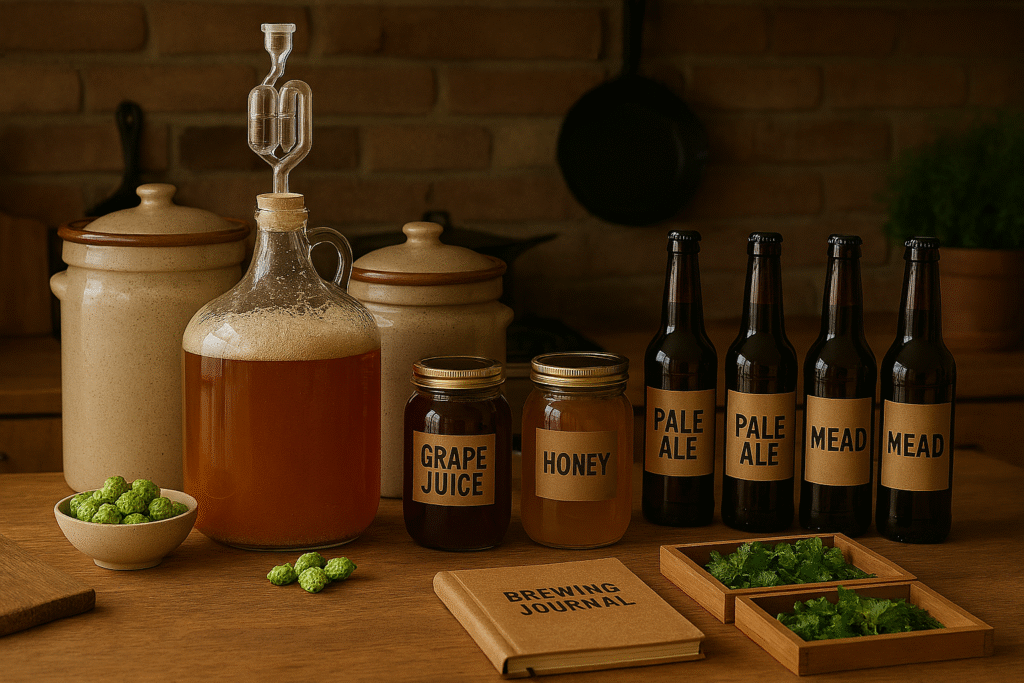
There’s something magical about transforming a few simple ingredients—water, grains, hops, fruit, and yeast—into a drink that bubbles or ferments with life. Homebrewing isn’t just about beer; it’s cider, wine, mead, kombucha, and even experimental fruit or spice-infused creations. By brewing at home, you gain control over flavor, ingredients, and, yes, sustainability. Plus, nothing beats the pride of pouring a glass of something you made yourself.
Why Homebrew?
- Flavor Freedom – Adjust sweetness, bitterness, or spice. Make it bold, subtle, or delightfully weird.
- Ingredient Control – Use organic fruits, local honey, or specialty grains for a truly homegrown experience.
- Sustainability – Less packaging, fewer trips to the store, and a smaller carbon footprint.
- Fun & Creativity – Experiment, label your bottles, and maybe start your own little tasting club.
Types of Homebrews
- Beer – The classic. From crisp lagers to hoppy IPAs, there’s a style for every palate.
- Cider – Apple, pear, or berry—cider is a naturally sweet alternative to beer.
- Mead – The oldest known alcoholic drink, made from honey, water, and yeast. Yes, you’re basically a medieval alchemist.
- Wine – From grapes to berries, homemade wine lets you explore complex flavors and vintages in your own kitchen.
- Kombucha & Fermented Drinks – Non-alcoholic, probiotic-rich beverages that add a tangy punch to your hydration game.
Getting Started
- Choose Your Brew – Decide on beer, cider, mead, wine, or kombucha. Starter kits make it simple for beginners.
- Gather Equipment – You’ll need a fermenter, airlock, sanitizing solution, bottles, and caps. Wine also benefits from a siphon, corker, and wine bottles. For kombucha, glass jars and breathable cloths work.
- Follow a Recipe – Start simple. Recipes guide your first batches, then tweak as you gain confidence. Wine recipes may include grape juice, berries, or other fruits along with sugar and yeast.
- Sanitation is Key – Clean everything thoroughly. Contamination is the only thing that can ruin your masterpiece.
- Patience Pays Off – Fermentation takes time. Waiting is hard—but the reward is worth it. Wine, in particular, often benefits from longer aging for richer flavors.
Tips for Success
- Temperature Control – Keep your brew in a stable, moderate environment for consistent results.
- Keep Notes – Document ingredients, fermentation time, and tweaks for future reference.
- Experiment Gradually – Small tweaks first; you can go wild once you understand the process.
- Share & Celebrate – Homebrewing is meant to be shared. Friends and neighbors make great taste testers.
Recommended Products for Homebrewers
- Beginner Beer Brewing Kit – Everything you need for your first batch of beer.
- Wine Making Kit – Includes fermenter, yeast, and ingredients for your first wine batch.
- Fermentation Bucket with Airlock – Ensures a clean, controlled fermentation process.
- Hydrometer – Measure sugar content to gauge alcohol levels and fermentation progress.
- Siphon & Corker – Essential tools for bottling homemade wine.
- Sanitizing Solution – Prevents contamination and off-flavors.
- Homebrew Recipe Books – Endless inspiration for flavors, styles, and techniques, including wine.
We earn a commission if you make a purchase, at no additional cost to you.
Homebrewing is a perfect blend of science, art, and patience. It’s about learning, experimenting, and savoring the fruits (or grains!) of your labor. Whether you’re in it for the flavor, the sustainability, or just the pride of creating something from scratch, homebrewing brings a touch of magic to your homestead.
Homebrewing isn’t just about making beer — it’s about crafting something unique, learning along the way, and enjoying the rewards of your own hard work. If you’ve ever wondered how to homebrew beer at home, you’re in the right place. This hub is your complete guide to homebrewing for beginners and seasoned brewers alike. From choosing the best homebrewing equipment and starter kits to step-by-step beer brewing tutorials, recipe ideas, and troubleshooting tips, you’ll find everything you need to brew great-tasting beer in your own kitchen or garage. Whether you want to experiment with new flavors, master all-grain brewing, or simply pour your first pint of homemade beer, these pages will help you get there.
Our homebrewing pages are currently being crafted, so check back soon as we tap fresh guides, tips, and recipes to help you brew like a pro.
Getting Started
- Homebrewing 101: A Beginner’s Guide
- Essential Equipment for First-Time Brewers
- Choosing Your First Homebrew Kit
- Understanding Ingredients: Malt, Hops, Yeast, and Water
Brewing Techniques
- Extract vs. All-Grain Brewing
- Step-by-Step: Brewing Your First Beer
- Fermentation Basics & Tips
- How to Bottle and Store Homebrew Beer
- Common Mistakes (and How to Avoid Them)
Styles & Recipes
- Easy Recipes for Beginner Brewers
- Seasonal Brewing (Fall Ales, Winter Stouts, Summer Wheat Beers)
- Experimenting with Flavors: Fruit, Spices, and More
- Clone Recipes: Recreating Popular Beers at Home
Advanced Brewing
- All-Grain Brewing: The Complete Guide
- How to Build a Homebrew System
- Water Chemistry for Better Brewing
- Kegging vs. Bottling: Which is Best for You?
- Scaling Up: From Hobbyist to Small Batch Craft Brewing
Troubleshooting & Tips
- How to Sanitize Brewing Equipment
- Fixing Off-Flavors in Your Beer
- Carbonation Problems Solved
- Best Practices for Consistency
Fun & Extra Content
- Pairing Food with Homebrew Beer
- History of Homebrewing
- Homebrewing Laws & What You Should Know
- Homebrew Competitions and Clubs
